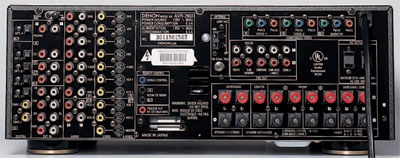Denon AVR-2803 Digital Surround Receiver Page 2
I had no problems hooking up the receiver to an all-full-range multichannel speaker system. Channel balancing was easily accomplished with the built-in test tone and the rare ability to adjust the trim controls in half-decibel steps - a very pleasant surprise in a mid-level receiver. If you have a subwoofer/satellite speaker system, you'll be pleased to hear that the AVR-2803's generally excellent bass-management system provides a selection of subwoofer crossover frequencies (40, 60, 80, 100, or 120 Hz). Unfortunately, but typically, the multichannel analog input receives no bass management at all. That's the main reason I used large speakers all around, because it avoids this issue entirely. It also gives the power-amplifier section a real workout since there's no powered subwoofer to assume much of the burden of reproducing bass from the main channels. 
|
Surprisingly, the DSP modes do not include a "Concert Hall," which I'd have thought was standard equipment. While adjusting the room-size parameter of the Jazz Club mode upward or that of the Rock Arena mode downward may sometimes do the trick, depending on the music, I found that DPL II's Music mode gave pleasant results with more types of music and with less fiddling than any of the Denon's DSP ambience modes. Besides, the most realistically enveloping ambience comes with original multichannel music recordings.
A prime example is the Philips SACD of Dvorak's complete Slavonic Dances conducted by Ivan Fisher. As heard over the AVR-2803, this proved to be the best-sounding recording these delightful works have ever received. For once the bass drum is audible as a very low-frequency presence - on other recordings you usually can't tell there's a bass drum at all.
You do get prominent booms - 6.1 channels of them, in fact - from the soundtrack of Harry Potter and the Chamber of Secrets, which contains quite a few passages to test the abilities of any home theater setup. My favorite scene is when the flying car meets the Whomping Willow (Chapter 8), which contains a wealth of quieter details among the overall sonic mayhem. The AVR-2803 did just fine with both the mayhem and the subtleties.
Given such performance, I can only conclude that Denon's AVR-2803 would find a place in just about any home theater, even a fairly large one. Considering its combination of features, usability, performance, and price, it's a bargain.
In the Lab
DOLBY DIGITAL PERFORMANCE All data were obtained from various test DVDs using 16-bit dithered test signals, which set limits on measured distortion and noise performance. Reference input level is -20 dBFS, and reference output is 1 watt into 8 ohms, which was obtained with the volume control set to read +2.5 dB. Except for subwoofer-related tests, all speakers were set to "large," subwoofer on. All are worst-case figures where applicable.
Output at clipping (1 kHz into 8 ohms) 1 channel driven: 124 W (21 dBW) 5 channels driven: 83 W (19.25 dBW) 6 channels driven: 75 W (18.75 dBW)
Distortion at 1 watt (THD+N, 1 kHz) 8 ohms: 0.029%
Noise level (A-wtd, 16-bit signals): -76.5 dB
Excess noise (with sine tone) 16-bit (EN16): ±0 dB
Frequency response 20 Hz to 20 kHz +0.22, -0.38 dB
MULTICHANNEL PERFORMANCE, ANALOG INPUT Reference output level 1 watt (8 ohms) from a 200-mV input; volume setting for reference output level was -1.5.
Distortion (THD+N, 1 kHz, 8 ohms): 0.009%
Noise level (A-wtd): -95.6 dB
Frequency response 20 Hz to 100 kHz +0, -2.7 dB
BASS MANAGEMENT Measured results with Dolby Digital test signals.
Subwoofer-output frequency response 24 dB/octave rolloff above -6-dB point at selected crossover frequency
High-pass-filter frequency response 12 dB/octave rolloff below -3-dB point at selected crossover frequency
Maximum unclipped subwoofer output (at reference volume setting, subwoofer trim at 0) 7.9 volts
Subwoofer distortion (from 6-channel, 30-Hz, 0-dBFS signal; master volume at reference level; subwoofer trim set to 0) 0.91%
Response consistency: no changes with source or media
Source consistency: no bass management for external multichannel audio input
Media consistency: no bass management for two-channel analog inputs unless a DSP mode is engaged
Speaker-size selection: all channels can be set to "small"
Speaker-distance compensation: available for all channels
- Log in or register to post comments














































